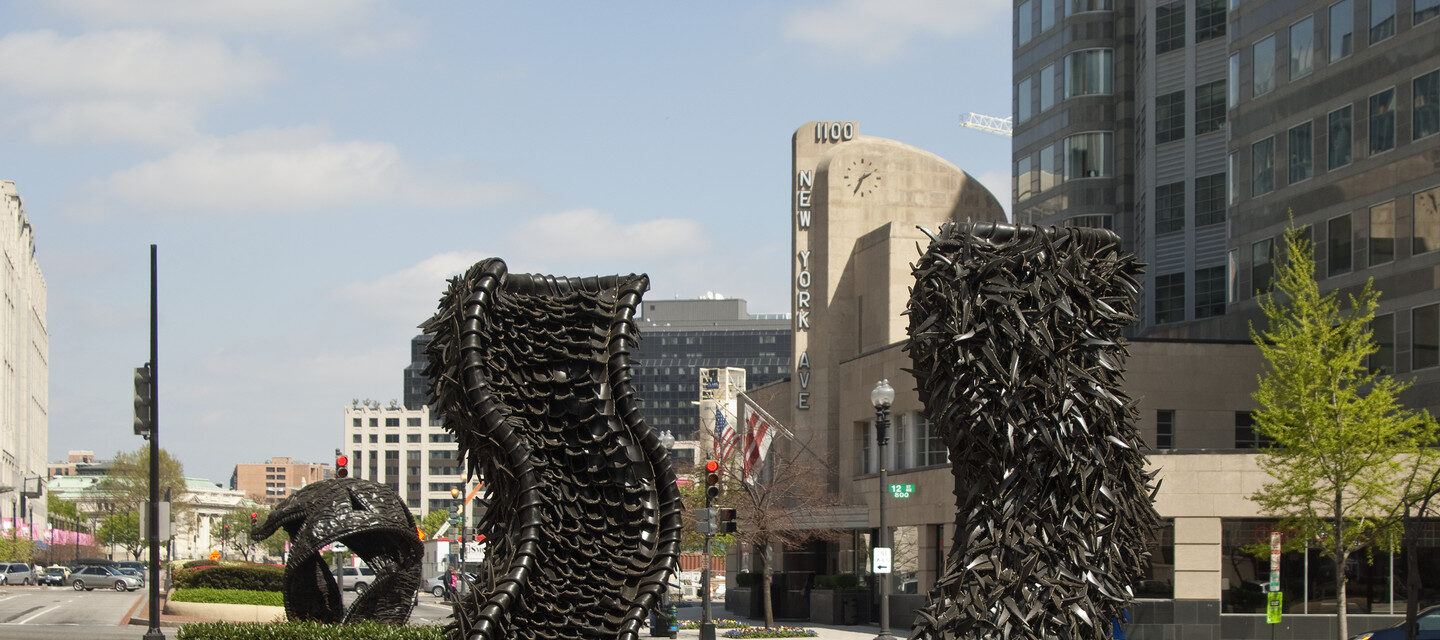
Chakaia Booker’s creative process involves exploring and exploiting the full artistic potential of rubber tires. She carefully selects tires with easy-to-cut, worn-out treads in order to transform them into her desired shapes. To fabricate her largest sculptures, Booker uses computer-aided design software, creates detailed models, and constructs armatures from pressure-treated wood and steel rods.
Just as Saint Phalle merged seemingly dichotomous techniques to create her Nanas, Booker complicates the conventions of femininity by combining traditionally feminine pursuits, weaving and handiwork, with industrial technology, typically seen as a masculine domain. She uses saber saws, band saws, reciprocating saws, miter saws, and drills to form the rubber loops, shards, knots, and folds on the surfaces of her sculptures. Varying her technique, chopping, slicing, shredding, curling, Booker transforms the rigid, dense material into pliable, evocative works.
Though her sculptures are meticulously and beautifully crafted, Booker intends for her art to exist and be understood beyond aesthetics. For her, tires are a means of communicating her ideas about society, human behavior, and expression. For example, in wheels, Booker sees a paradox of human perception. Wheels suggest mobility and progress, but also the way humankind confines itself to old ideas and attitudes. Tires are analogous to the cycle of life: people start out like freshly-treaded tires, but are eventually worn down with time and experience. Tires are also a source for environmental, political, and cultural metaphors.

Booker’s abstractions may be seen as a statement of racial identity, with tread patterns evoking African motifs used in fabrics and other artwork. But they are also intended to represent cultural diversity. Through the rust stains, textures, remaining treads, movement, and coloration of the sculptures, Booker challenges preconceived notions that tires are uniformly black, encouraging people to reexamine presumptions about subject matter, human beings, and perceptions. The evocative titles of her sculptures (such as Serendipity, Spirit Hunter, and Dialogue with Myself) are based on situations that have occurred in the artist’s own life and in the lives of others. As Booker says, “My sculptures are about the recognition of a universal experience, an emotional exchange between people, and the spiritual.”

The Sculpture Project will showcase four works by Booker, three of which she sculpted in 2008. Gridlock, a symbol of human journey and life, shows an interplay of concave and convex spaces. The title references travel patterns, which fittingly suits New York Avenue’s bustling traffic. Take Out is a whimsical piece embellished with large, looping, swirling tendrils of tire. Evoking photographs and reflections through its frame- or mirror-like rectangular shape, Take Out invites viewers to explore and engage in the New York Avenue cityscape.
The smoother, more subtle Pass the Buck is inspired by Madam C. J. Walker, a National Women’s Hall of Fame honoree and early-twentieth-century businesswoman and philanthropist, best known for developing a successful line of hair-care and beauty products for black women. A tight sphere of intricate, interlocking pieces of rubber, the work symbolizes upward mobility, the pursuit of success, and giving back to society, it meaningfully underscores NMWA’s own commitment to recognizing the efforts of women artists. A fourth piece, called Shapeshifter, which Booker has specifically designed for the New York Avenue Sculpture Project, will be unveiled to the public for the first time this spring.
The New York Avenue Sculpture Project is currently funded through support from NAB member Medda Gudelsky and the Homer and Martha Gudelsky Foundation. In-kind support is provided by Michelin North America Inc.
